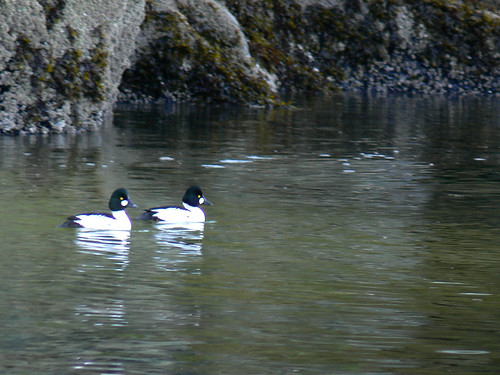Duck Tails !
Have you spotted any Barrow’s Goldeneyes with a transmitter tail?

There's a new fashion statement this spring for the Goldeneye ducks on Indian Arm. Twenty of our winter residents are sporting radio transmitters.
Drs. Sean Boyd of Environment Canada and Dan Esler at Simon Fraser University and Pacific WildLife Foundation, are leading a research team studying Barrow’s Goldeneye. In February twenty birds were captured in nets in Belcarra and Bedwell Bay. They were fitted with a radio transmitter, and released back into Indian Arm. Over the next 1-2 years the team will study the data from these transmitters to learn more about the migration and geographic distribution patterns of these interesting winter residents.
Scientists concerned about declining sea duck populations are working together to describe abundance trends and migration patterns, identifying coastal and freshwater habitats and determining what contaminants, disease and developments might affect these ducks. For more information, visit the Sea Duck Joint Venture at www.seaduck.org
... Male and female goldeneye ducks in Indian Arm - March 2007
and two male Barrow's Goldeneyes in Whiskey Cove - March 2007
Two kinds of Goldeneye Ducks winter on Indian Arm. Common Goldeneye males are black and white and have a quarter moon-shaped patch below the eye. The Barrow's Goldeneye male is the same coloring, but has a full moon circle patch below the eye. The female goldeneyes are brown. They are named for Sir John Barrow, an English explorer who traveled in the Arctic.
Their fast wingbeat makes a loud whistling sound in flight, giving them the nickname Whistler. They make hoarse croaking sounds -- “krawk” as they cluster along the rocky shore and around docks feeding on mussels, crustaceans and plants.
Sea ducks are a large and diverse group including Mergansers, Scoters, Harlequin Ducks, Bufflehead, Eiders, and Goldeneyes. There are fifteen North American species and 4 distinct races -- Pacific, Northern, Hudson Bay, American. Adapted to sea and land, they winter along marine coasts and return to breeding grounds in freshwater lakes and rivers in northern latitudes. They nest in tree cavities or on the ground.
Sea ducks are biologically different from other groups of waterfowl. Scientists don’t know much about them yet, even some of the most basic biological facts. Several species have been declining for years, and they want to know why.
March 15/2007 Update Sean Boyd says, "The birds transmitting are still in the Indian Arm area. Some birds have moved a bit (10km or so) but most are still around the area of capture. Interestingly, we marked a male goldeneye at Riske Creek (near Williams Lake) in May 2006 and that bird has been in Indian Arm all winter and lately in the same area as our more recently (winter) marked birds, perhaps hanging out with other birds with antennae."
The Barrow’s Goldeneyes will be leaving our area in the next few weeks. If you see a duck with an antenna like a long tail, you will know it is one of the ducks that are part of this study. If you get a good photo of the ducks, please forward it to colleenmacd@gmail.com. I will continue to keep you informed about the study.
May 2015 Update: Barrow’s goldeneyes (BAGO)